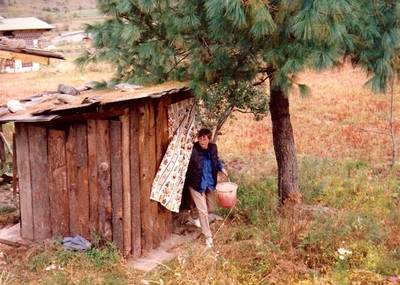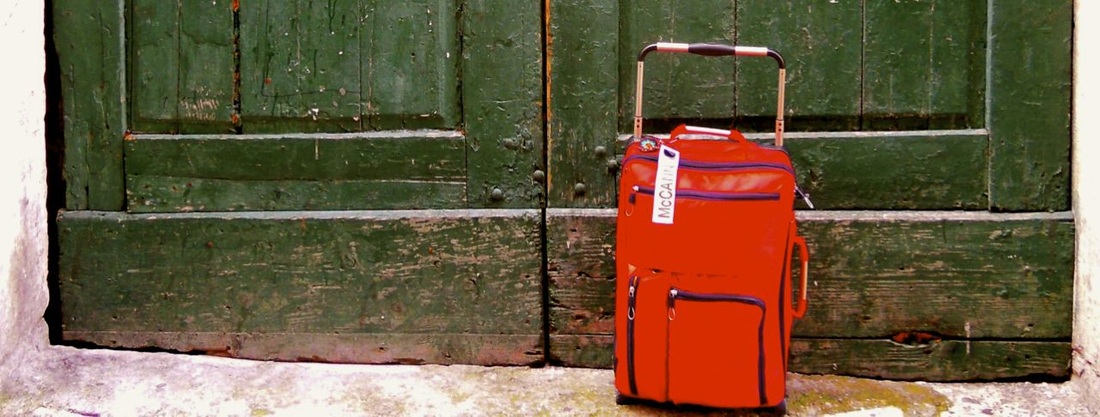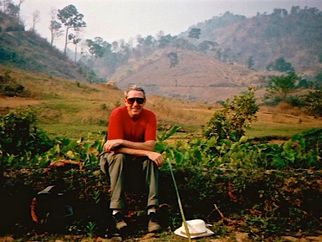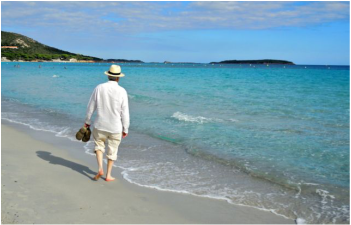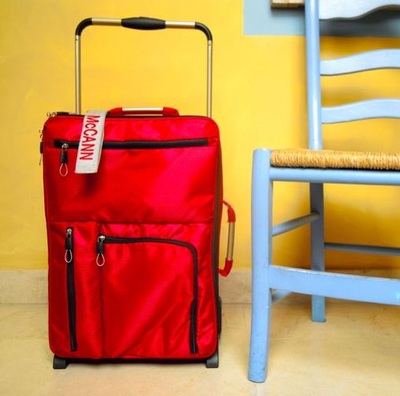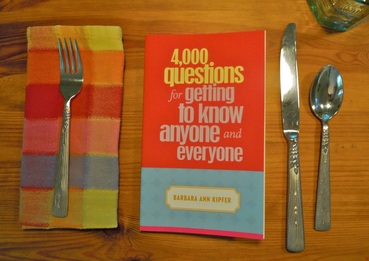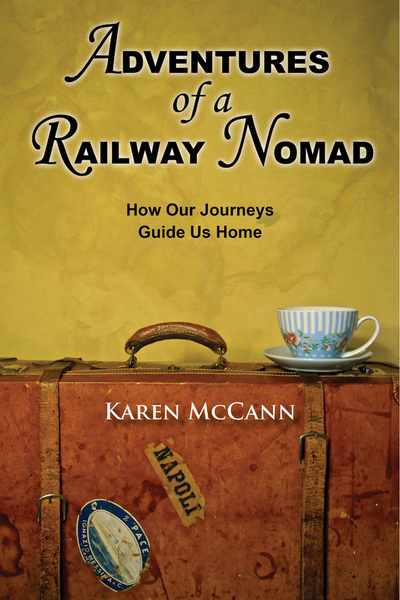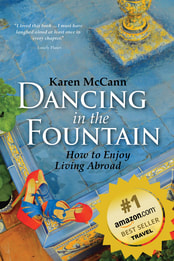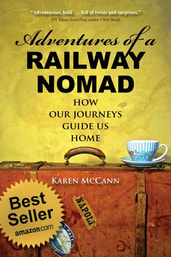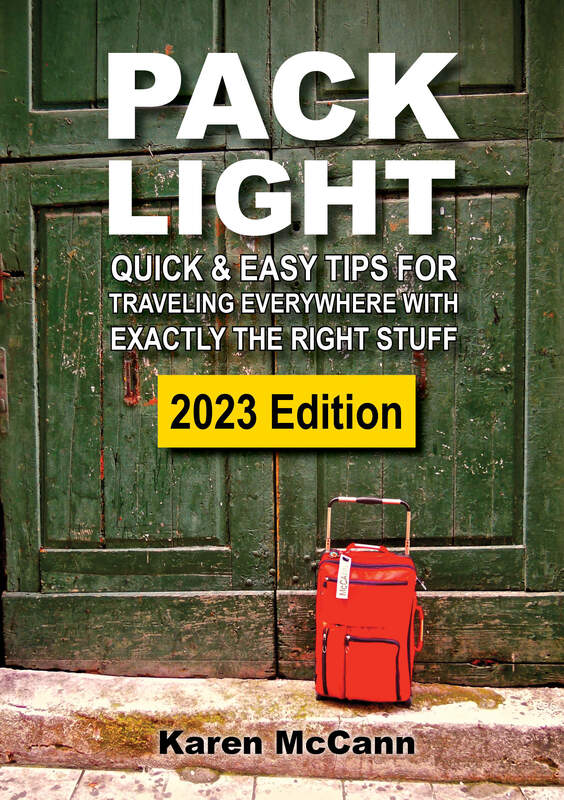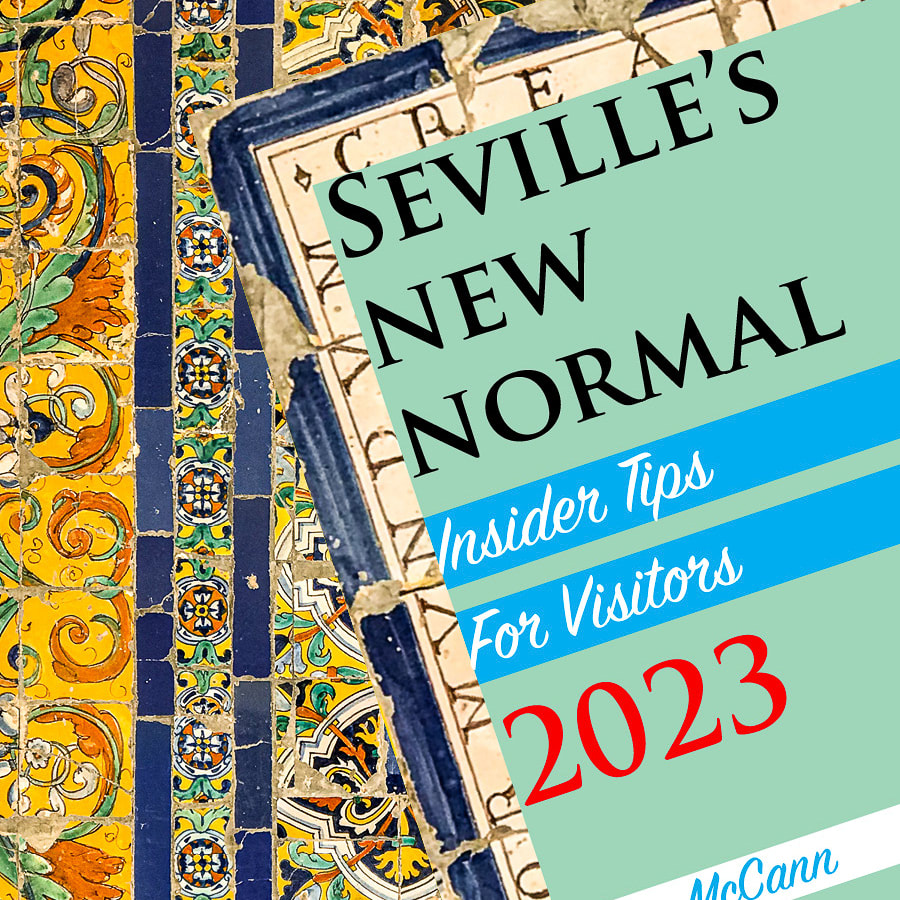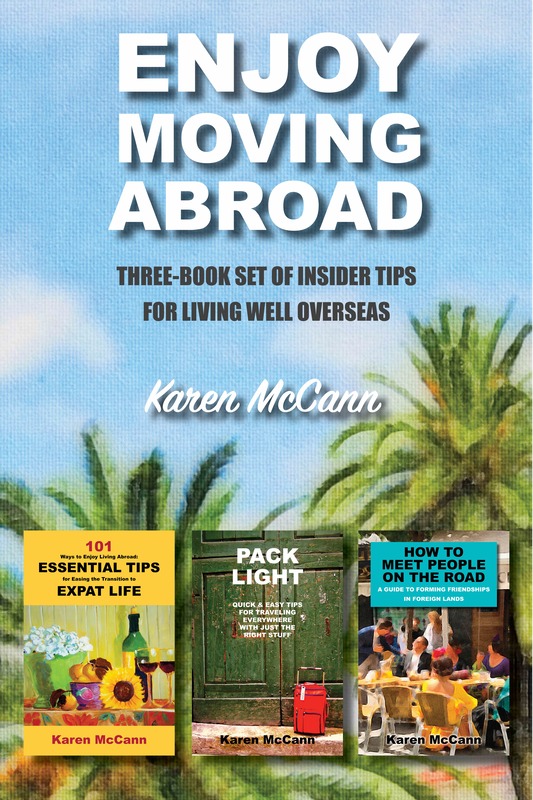|
I was skimming through some questions Johnny Jet sent me in preparation for appearing in his Travel Style Q&A section when I came to that one. My worst travel moment? A montage of hideous memories flashed through my mind. 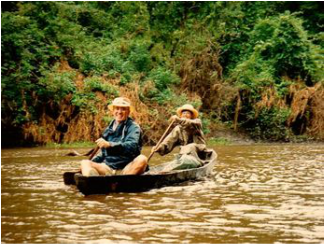 Heading back to base camp after our Amazon camping trip Heading back to base camp after our Amazon camping trip There was the time Rich and I went camping in the Peruvian Amazon, 18 miles by canoe from the modest comforts of our base camp. The jungle was alive with mosquitoes, fire ants, caimen (an alligator-type reptile), monkeys, and, as the guides casually mentioned while starting a cooking fire, probably bushmasters, the incredibly aggressive, poisonous, 14-foot snakes that are attracted to light and heat. Then the big storm hit. In moments all the humans were huddled together inside the leaky tent, water dripping down our necks to pool on the floor. Just when I though I couldn’t feel more miserable, one of the guides said, ““Don’t go out of the tent tonight. But if you do, there’s a machete by the door. Use it.” Immediately I pictured myself standing outside in the torrential downpour, machete in one hand, flashlight in the other, trousers down around my ankles, fending off a ravenous bushmaster. The guide added helpfully, “If you just have to take a leak, we have plastic bags.” That was at 6:00 pm. It was a long, long night. But did that really trump the horror of getting stranded alone in the middle of the night in a very dubious New Delhi neighborhood? 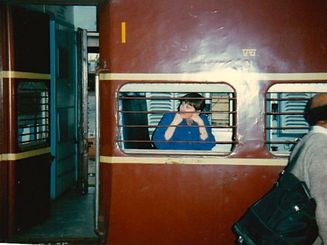 On the train in India On the train in India Rich and I had taken the overnight train down from the Pakistani border, and hours before our scheduled arrival time in New Delhi, the train lurched to a stop and stayed there. Rich stumbled out into the corridor to ask someone where we were. “Delhi,” the man said. Rich burst back into the compartment. “We’re here! Get your stuff! We have to get off!” Three minutes of mad scrambling and we were out the door, running down the corridor and leaping off the train. It was only then that I noticed there was no sign marking the station. Were we really in Delhi? I looked around for someone to ask, but the platform was deserted except for a dozen people sleeping curled up under what appeared to be burlap sacks, and a few glowering youths leaning against the back wall. Then Rich said, “Do you think we left anything behind?” And before I could say “Who cares?” he had jumped back on the train and dashed up the corridor. And that, of course, is when the train took off. Yes, that was definitely among my worst travel moments. You can imagine my relief when Rich reappeared and made a flying leap off the train onto the platform. And the station did, in fact, did turn out to be in New Delhi, although nowhere near the downtown area we actually wanted. 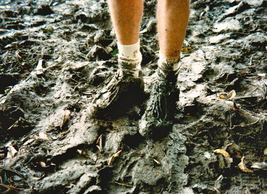 A muddy hike in Peru A muddy hike in Peru But how to choose the very worst moment? What about the time we were on a small, private plane in Mexico, and I looked over to see a plane exactly like ours that had crashed and been dragged to the side so we could take off? And who could forget that toilet hut in rural Guatemala, the one that was so gruesome I simply threw away my shoes afterwards? Bad times make for good stories. Nobody wants to hear about the connections we make with ample time, the flawless white sand beaches we stroll upon, or the bartenders who really know how to fashion a dry martini. As delightful as such experiences are when they happen to me, I find telling those stories to others tends to elicit yawns and snores. But we all love listening to tales of disasters averted and challenges overcome. There’s nothing like a narrow escape for reminding us how sweet life can be. So ... worst travel moment ever? I’m still not sure, but I think it might have something to do with white sand beaches and a perfect dry martini. What's your worst travel memory? Your best? Are they one and the same? YOU MIGHT ALSO ENJOY
5 Comments
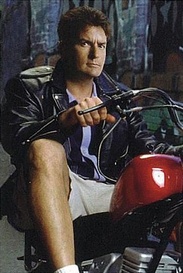 Charlie Sheen Charlie Sheen It’s easy to get the impression that long journeys have to be insanely expensive. You simply calculate the cost per day of your honeymoon in the Caribbean or your last business trip to New York, multiply that times 30 or 90 or 120 days, and try not to suffer cardiac arrest when you see the total. But travel doesn’t need to be lavish and pricey. In his classic book Vagabonding, Rolf Potts writes about watching Charlie Sheen play a hyperambitious character in Wall Street who says, “I think if I can make a bundle of cash before I’m thirty and get out of this racket, I’ll be able to ride my motorcycle across China.” Watching this scene, Potts recalls, “I nearly fell out of my seat in astonishment. After all, Charlie Sheen or anyone else could work for eight months as a toilet cleaner and have enough money to ride a motorcycle across China.” You’ll be glad to hear that scrubbing toilets isn’t your only – or best – option for financing extended time on the road. If you have a day job, save up your vacation days and research ways to travel on a shoestring. You’d be amazed at how long and far you can go without spending much – and still enjoy comfort and security.  Student in Vietnam. Photo by Tieu Hoc Student in Vietnam. Photo by Tieu Hoc Ready for a more real change of pace? Think about living abroad for a while – like my nephew Mason, who is heading off to teach English in Vietnam. How did he discover this golden opportunity? You guessed it: an online search. Google “working abroad” and you’ll get 45 million hits. True, many of these "jobs" are volunteer assignments or have such low pay they might as well be. But for Mason and countless others heading overseas with stars in their eyes, it’s the adventure not the paycheck that counts. If you’ve got a serious case of wanderlust, you may want to consider becoming a digital nomad, finding or creating an online job that makes you location independent. My friends Lindsay and Ross have been on the road since 2008, working via the Internet and moving every three to six months, exploring three or four new countries every year. “It’s really not a question of why we do it,” says Lindsay. “It’s more a question of why doesn’t everyone do it?” 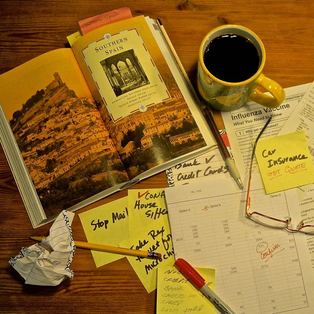 One reason you may hesitate to wander the world is that the logistics can be daunting. Where should you go? How can you keep up with your current responsibilities (family, bills, taxes) remotely? What kind of work will cover your expenses and still leave you time to explore? After all, there’s no point in leaving one rat race for another. Luckily, there are some fantastic resources, including Nora Dunn’s massive, new Working on the Road: The Unconventional Guide to Full-Time Freedom. In 2006 Nora gave up a career as a financial planner to become the Professional Hobo, a perpetual nomad writing about financially sustainable travel. Her newest project is an electronic workbook filled with budget templates, checklists, and other vital resources. How good is she at stretching travel dollars? In all of 2013 she spent just $1,718 on lodging – about what many people pay every month in rent. And she’s hardly slumming. Her accommodations have included a 49-foot sailboat in the Caribbean, a cottage in the Swiss Alps, and a Hawaiian yurt. Another reason many of us hesitate to travel long-term is because we know that travel changes us, sometimes in unpredictable ways. Young travelers expect to come home transformed. While their hopes of returning a worldly-wise, unutterably cool sophisticate and sexual virtuoso may not be fully realized, exposure to the larger world usually broadens horizons and rubs off a few rough edges. Middle-aged travelers, on the other hand, frequently just want to return feeling rested. But no matter what your age, every road trip is really an inner journey. “Travel,” writes LA Times travel editor Catharine Hamm, “requires you to be braver than you think you are, whether it's for a week or a year, and involves the joy of finding a better, smarter, stronger self that lasts well past the day you put away your suitcase if, indeed, that day ever comes.” And that, my friends, is priceless. YOU MIGHT ALSO ENJOY
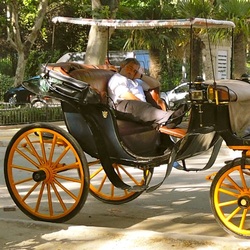 Inspiration for a story on siestas. Inspiration for a story on siestas. “The trouble with my line of work,” a clergyman once told me, “is that every little thing that happens during your day makes you think, ‘Is this material for a sermon?’” Being a travel blogger has much the same effect. At home or abroad, even the smallest stuff – a sleeping cabby, an old lady selling snails, someone wandering the streets in pajamas – can spark an idea for a post. Even when I’m trying to describe a magnificent setting, it’s usually the small, personal details – an impossible "fact," a goofy mistake, someone's snarky remark – that make the story come alive. Being a blogger motivates me to pay closer attention to my surroundings and the astonishing things people do and say. It keeps me on my mental toes. You might want to launch your own blog for all sorts of reasons. Maybe you want a better way to share vacation photos and anecdotes with family and friends, especially if you have something special in mind this year. You could have a message you want to share, such as the importance of travel for mental and spiritual growth. It may be time to explore a career as a travel writer, and you want to start building an audience so you can attract sponsors and paid assignments. Whatever you may have in mind, here are a few pointers to get you started.  Wandering Earl: Not just another travel blogger Wandering Earl: Not just another travel blogger Study successful travel bloggers. Check out the 50 most popular travel blogs of 2014; Matador Network’s roundup of slightly edgier stories; and my personal faves. Read articles such as the Huffington Post’s How to Blog Like an Expert: Tips from the 10 Best Travel Blogs. If you’re serious about going pro, consider joining Travel Blog Success for online support and ideas. Then throw out the rulebook. “If I were to listen to all of the advice out there about how to blog correctly, I probably wouldn’t still be blogging today,” says the phenomenally popular Wandering Earl. “ I remember trying to figure out ‘how to blog’ when I first started and I also remember getting a headache after every research session . . . If you don’t do this your blog will explode, if you don’t do that you’ll never, ever, ever, ever have any readers.” His advice? “Be yourself, not just another travel blogger.”  Shopping for a flamenco dress in Seville Shopping for a flamenco dress in Seville Hone your writing skills. Leave out the boring bits! Cut to the chase! Make the experience come alive for your readers! Put a little “ouch” in your stories; people love to read about overcoming obstacles. Spend time studying your craft. Develop your own voice. And proofread! Tripping over typos and awkward phrasing is painful for your readers, and mistakes undermine your work’s credibility. Give your travel photos zing. Take your camera everywhere; the best way to improve is to snap photos constantly. Make friends with your computer’s photo editing program; I use iPhoto to crop, boost, and enhance photos until they go from “uh” to “ahhh!” Study high-end pros such as National Geographic for inspiration and ordinary bloggers for down-to-earth tips. Learn the technology. (It’s not that hard. Really!) Adventurous Kate’s How to Start a Travel Blog is a great, step-by-step introduction. She uses WordPress as her publishing platform (you’ll learn what this is in her article), where I prefer Weebly; both are great, and there are plenty of others out there.
Finding that online map got me thinking about the technology of blogging – which led to this post. And in checking my facts, I learned that every 7.4 seconds a new blog goes online; there are more than eight million out there already, with nearly three million articles being posted every day. So why should you add one more? Because it’s great fun, and every new blog brings a fresh voice into the worldwide conversation. If you’re thinking of starting a blog, or have one that’s been up and running a while, I’d love to hear your thoughts and advice for others in the blogosphere.
All blogs, websites, products, and services referred to in this post are included solely because I believe you might find them interesting and useful in planning your own blogging adventures. Unlike some of my better-organized and more practical blogger friends, I do not accept sponsorships of any kind. YOU MIGHT ALSO ENJOY  Howler monkeys: unimpressed with my freshly ironed dresses. Howler monkeys: unimpressed with my freshly ironed dresses. Before Rich and I started our global wanderings, I had no idea how to pack. I remember on our honeymoon (Sherman, set the Wayback Machine to 1987) taking contact lenses, must-iron cotton dresses, and a tiny steam iron that for some reason required salt. I used to swipe salt from restaurants, pouring it into napkins that leaked granules all over my pockets. Rich took a suit jacket, collared shirts, possibly even a tie. All this would have made (some) sense if we were traveling in a civilized manner, but we were tramping through the jungles of Costa Rica, and I found the howler monkeys and parrots weren’t particularly impressed with such sartorial niceties. It was definitely a dress-down environment, and we soon saw the wisdom of leaving the better clothes at the bottom of our suitcases – which in those days were the bulky, old-fashioned kind without wheels. 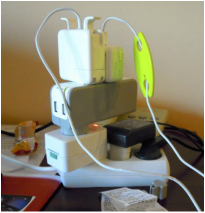 Since then, we’ve traveled to dozens of countries (our total now stands at 48) and have learned the value of streamlining. We now have little roll-aboards measuring 21 x 13 x 7.5 inches (54 x 34 x 19 cm) and weighing just four pounds (1.8 kilos); fully packed they usually run about 20 pounds (9 kilos). Our clothes are fast-drying and wrinkle-resistant; I threw out that ridiculous steam iron decades ago. We’ve spent years looking for the best shoes, toiletries, first aid kits, laundry supplies, security measures, garments with hidden pockets, gadgets, and gear. Lately, of course, we’ve been working out how to manage the electronic devices that none of us seem able – or inclined – to live without. What apps and devices do we really need? How can we keep all our cords, chargers, and other e-accessories organized? What do we do if a cord gets lost? (Helpful hint: check with the hotel desk. They often have vast collections of left-behind cords and other accessories; you may be able to replace yours without spending a cent.) 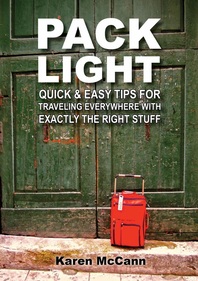 I’m often asked how I live out of a single small suitcase for months at a time and recently decided to collect my best strategies in a new guide called Pack Light: Quick & Easy Tips for Traveling Everywhere with Exactly the Right Stuff. The guide is as streamlined as my suitcase: modest in its dimensions, but packed with useful things. Not everyone is on board with the idea of traveling light. Paris Hilton, for instance, arrived for a single month’s visit to southern Spain with nineteen suitcases. The unpacking, she said, “was brutal.” The poor kid. At the other end of the scale is Lee Child’s fictional protagonist, Jack Reacher, who travels with nothing. Every two or three days he buys all new, inexpensive clothing in a chain store and throws away every stitch he had on. Rich has long harbored a hankering to travel that way, but so far I’m holding firm on the need for my little red suitcase filled with life’s essentials. When it comes to packing, are you a Jack Reacher or a Paris Hilton? Chances are you’re somewhere in between. Most of us are trying to figure out how to take along everything we need for comfort and style, without a lot of excess baggage that will slow us down. “You’ll never meet a traveler who, after five trips, brags ‘Every year I pack heavier,’” observes travel guru Rick Steves. Packing light means more freedom and mobility, so you can go out and enjoy the parrots instead of being stuck in in your hotel, scrounging for salt so you can steam-iron a cotton shirt. |
This blog is a promotion-free zone.
As my regular readers know, I never get free or discounted goods or services for mentioning anything on this blog (or anywhere else). I only write about things I find interesting and/or useful. I'm an American travel writer living in California and Seville, Spain. I travel the world seeking eccentric people, quirky places, and outrageously delicious food so I can have the fun of writing about them here.
My current project is OUT TO LUNCH IN SAN FRANCISCO. Don't miss out! SIGN UP HERE to be notified when I publish new posts. Planning a trip?
Use the search box below to find out about other places I've written about. Winner of the 2023 Firebird Book Award for Travel
#1 Amazon Bestseller in Tourist Destinations, Travel Tips, Gastronomy Essays, and Senior Travel
BLOG ARCHIVES
July 2024
CATEGORIES
All
|
